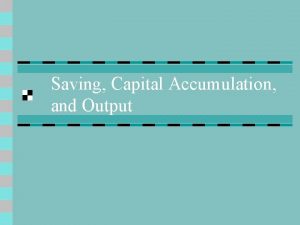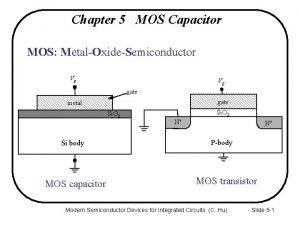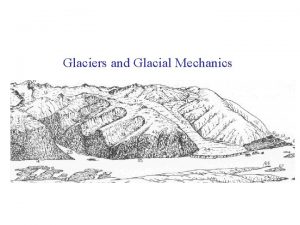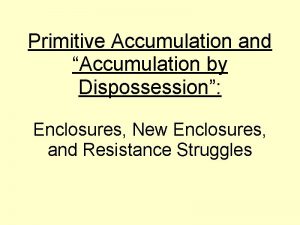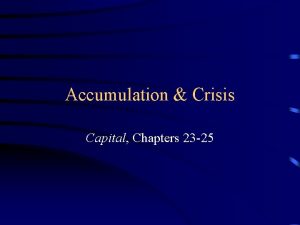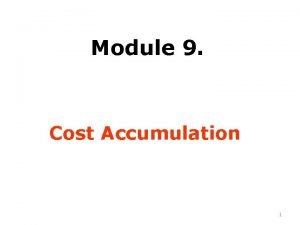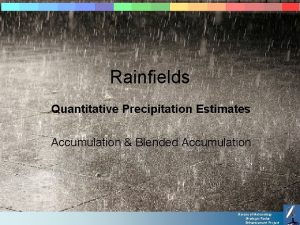Sections 1 5 1 6 Consider the accumulation



![ln[a(t)] – ln(1) = t • a (0) a(1) = 1 + i ln[a(t)] – ln(1) = t • a (0) a(1) = 1 + i](https://slidetodoc.com/presentation_image/ae1b766f8ffb9819c9bee4177813b4cf/image-4.jpg)

![1 With a simple interest accumulation function, [a(t)] = —— for t 0. 1 1 With a simple interest accumulation function, [a(t)] = —— for t 0. 1](https://slidetodoc.com/presentation_image/ae1b766f8ffb9819c9bee4177813b4cf/image-6.jpg)

- Slides: 7

Sections 1. 5, 1. 6 Consider the accumulation function a(t) = (1 + i)t for integer t 0. Interest accruing according to this function is called compound interest. We call i the rate of compound interest. Observe that this constant rate of compound interest implies a constant rate of effective interest, and the two are equal: a(n) – a(n – 1) (1 + i)n – (1 + i)n– 1 in = ————————— = 1 + i – 1 = i. a(n – 1) (1 + i)n– 1 Suppose we want to define a differentiable function a(t) so that for non -integer t, we preserve the following property: a(t + s) – 1 amount of interest earned over t + s periods, for one unit = [a(t) – 1] • a(s) + a(s) – 1 amount of interest earned over s periods, over t periods, for one unit, immediately reinvested for s periods

In other words, we want a(t + s) = a(t) • a(s). Observe that this property is true for the compound interest accumulation function a(t) = (1 + i)t but not for the simple interest accumulation function a(t) = 1 + it. That is, (1 + i)t + s = (1 + i)t (1 + i)s , and 1 + i(t + s) (1 + it)(1 + is).

Are compound interest accumulation functions the only ones which preserve the property? For a(t) to be differentiable, we must have a (t) = lim s 0 a(t + s) – a(t) • a(s) – a(t) —————— = lim ——————— s s 0 s a(t) (a(s) – 1) a(s) – a(0) ————— = a(t) lim ———— = a(t) • a (0) s s 0 s a (t) = a(t) • a (0) t 0 a (t) —— = a (0) a(t) t d — ln[a(r)] dr dr t a (0) dr = 0 ln[a(t)] – ln(1) = t • a (0) d — ln[a(t)] = a (0) dt a(t) = e t ln[a(r)] = r • a (0) 0 0 t • a (0)
![lnat ln1 t a 0 a1 1 i ln[a(t)] – ln(1) = t • a (0) a(1) = 1 + i](https://slidetodoc.com/presentation_image/ae1b766f8ffb9819c9bee4177813b4cf/image-4.jpg)
ln[a(t)] – ln(1) = t • a (0) a(1) = 1 + i = e a (0) a(t) = e t • a (0) = ln(1 + i) a(t) = et ln(1+i) We have a(t) = (1 + i)t for all t 0. Consequently, compound interest accumulation functions are the only ones which preserve the property.

Observe that (1) With simple interest, the absolute amount of growth is constant, that is, a(t + s) – a(t) does not depend on t. (2) With compound interest, the relative rate of growth is constant, that is, [a(t + s) – a(t)] / a(t) does not depend on t. What is the amount A(0) which must be invested to obtain a balance of 1 at the end of one period? 1 Since we want 1 = A(1) = A(0) • a(1) = A(0) • (1 + i), then A(0) = ——. 1+i 1 v = —— is called the discount factor. 1+i What is the amount A(0) which must be invested to obtain a balance of 1 at the end of t periods? Since we want 1 = A(t) = A(0) • a(t), then A(0) = [a(t)]– 1 is called the discount function.
![1 With a simple interest accumulation function at for t 0 1 1 With a simple interest accumulation function, [a(t)] = —— for t 0. 1](https://slidetodoc.com/presentation_image/ae1b766f8ffb9819c9bee4177813b4cf/image-6.jpg)
1 With a simple interest accumulation function, [a(t)] = —— for t 0. 1 + it – 1 With a compound interest accumulation function, 1 vt [a(t)] = —— = (1 + i)t – 1 for t 0. a(t) is said to be the accumulated value of 1 at the end of t periods, and [a(t)]– 1 is said to be the present value (or discounted value) of 1 to be paid at the end of t periods.

Find the present (discounted) value of $3000 to be paid at the end of 5 years (i. e. , the amount which must be invested in order to accumulate $3000 at the end of 5 years) (a) with a rate of simple interest of 7% per annum. 3000[a(5)] = ————— = $2222. 22 1 + (0. 07)(5) – 1 (b) with a rate of compound interest of 7% per annum. 3000[a(5)] = 3000 v 5 = ———— 5 = $2138. 96 (1 + 0. 07) – 1 t 2 (c) with the accumulation function a(t) = 1 + —. 25 3000 = $1500 3000[a(5)] = ———— 1 + (52/25) – 1
